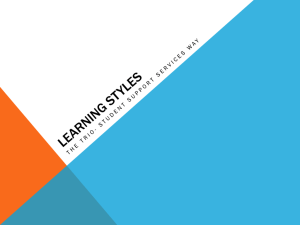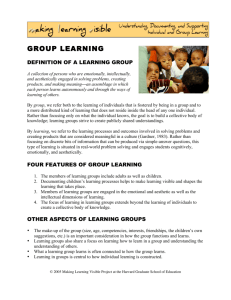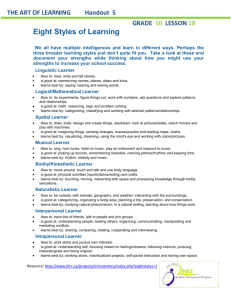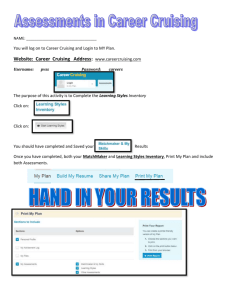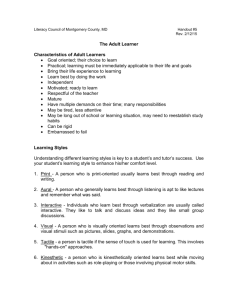1. Know Your Learning Style & Minute Papers
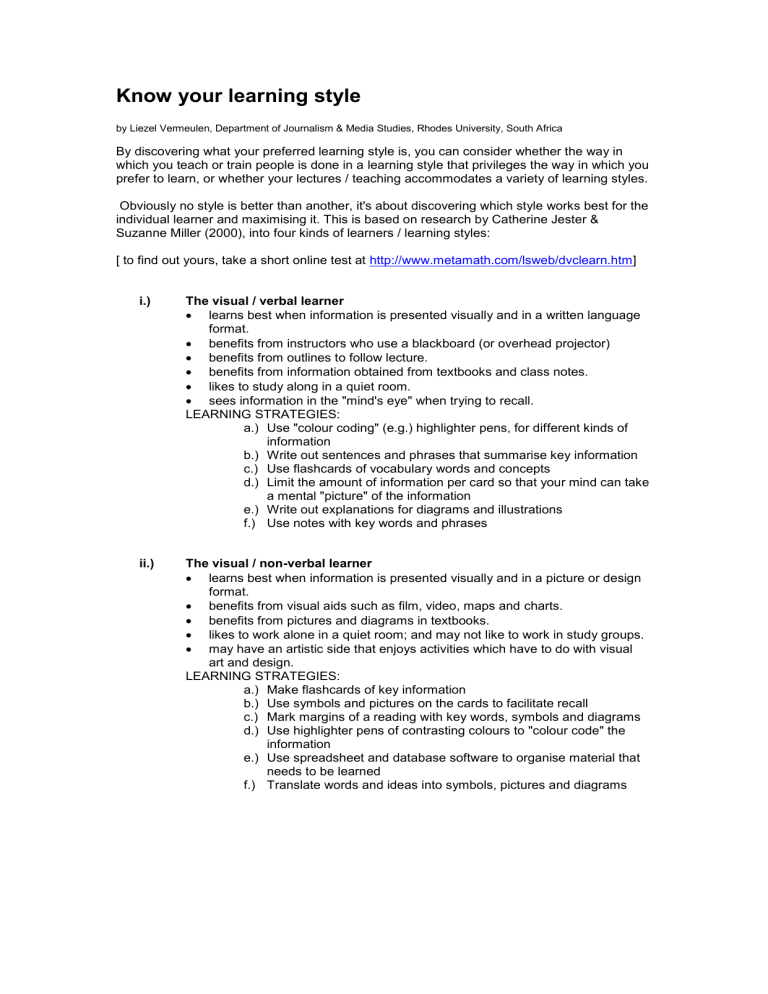
Know your learning style
by Liezel Vermeulen, Department of Journalism & Media Studies, Rhodes University, South Africa
By discovering what your preferred learning style is, you can consider whether the way in which you teach or train people is done in a learning style that privileges the way in which you prefer to learn, or whether your lectures / teaching accommodates a variety of learning styles.
Obviously no style is better than another, it's about discovering which style works best for the individual learner and maximising it. This is based on research by Catherine Jester &
Suzanne Miller (2000), into four kinds of learners / learning styles:
[ to find out yours, take a short online test at http://www.metamath.com/lsweb/dvclearn.htm
] i.) The visual / verbal learner
learns best when information is presented visually and in a written language format.
benefits from instructors who use a blackboard (or overhead projector)
benefits from outlines to follow lecture.
benefits from information obtained from textbooks and class notes.
likes to study along in a quiet room.
sees information in the "mind's eye" when trying to recall.
LEARNING STRATEGIES: a.) Use "colour coding" (e.g.) highlighter pens, for different kinds of information b.) Write out sentences and phrases that summarise key information c.) Use flashcards of vocabulary words and concepts d.) Limit the amount of information per card so that your mind can take a mental "picture" of the information e.) Write out explanations for diagrams and illustrations f.) Use notes with key words and phrases ii.) The visual / non-verbal learner
learns best when information is presented visually and in a picture or design format.
benefits from visual aids such as film, video, maps and charts.
benefits from pictures and diagrams in textbooks.
likes to work alone in a quiet room; and may not like to work in study groups.
may have an artistic side that enjoys activities which have to do with visual art and design.
LEARNING STRATEGIES: a.) Make flashcards of key information b.) Use symbols and pictures on the cards to facilitate recall c.) Mark margins of a reading with key words, symbols and diagrams d.) Use highlighter pens of contrasting colours to "colour code" the information e.) Use spreadsheet and database software to organise material that needs to be learned f.) Translate words and ideas into symbols, pictures and diagrams
iii.) The tactile / kinesthetic learner
learns best when physically engaged in a "hands on" activity.
benefits from a setting where you can manipulate materials to learn new information.
learns best when physically active in the learning environment.
benefits from demonstrations, "hands on" student learning experiences and field work.
LEARNING STRATEGIES a.) Sit near the front of a room b.) Jot down key words and draw pictures or make charts c.) When studying, walk back and forth and read information out loud d.) Copy key points onto a chalkboard, easel board, or another large writing surface e.) Make your learning tangible, i.e. something you can put your hands on iv.) The auditory / verbal learner
learns best when information is presented in an oral language format. benefits from listening to lectures and participating in group discussions.
benefits from obtaining information from audio-tape.
learns best when interacting with others in a listening / speaking exchange.
LEARNING STRATEGIES a.) Join a study group to assist you in learning course material b.) When studying alone, talk out loud to aid recall c.) Read notes out loud, tape record presentations and review tapes as often as possible
NOTE:
A learning style is the way you prefer to learn.
It has to do with how your brain works most efficiently to learn new information.
There is no good or bad learning style, no right or wrong.
By being aware of your learning style, you will learn more effectively.
This perspective on learning styles uses different channels of perception as a model -- seeing, hearing, touching / moving. It's a simplistic view of the brain, but a good place to begin.
There can be a good and bad match between the way you best learn and the way a particular course is taught.
Minute Papers
by Liezel Vermeulen, Department of Journalism & Media Studies, Rhodes University, South
Africa
Purpose:
A quick and easy way to collect written feedback on what participants have learned.
Process:
The instructor simply stops the class two or three minutes early and asks participants to respond briefly to the following questions: a.) What was the most important thing you learned during the class? b.) What important question remains unanswered for you?
Outcome:
Despite their simplicity, minute papers assess more than mere recall. In order to select the most important or significant information, learners must evaluate what they recall.
